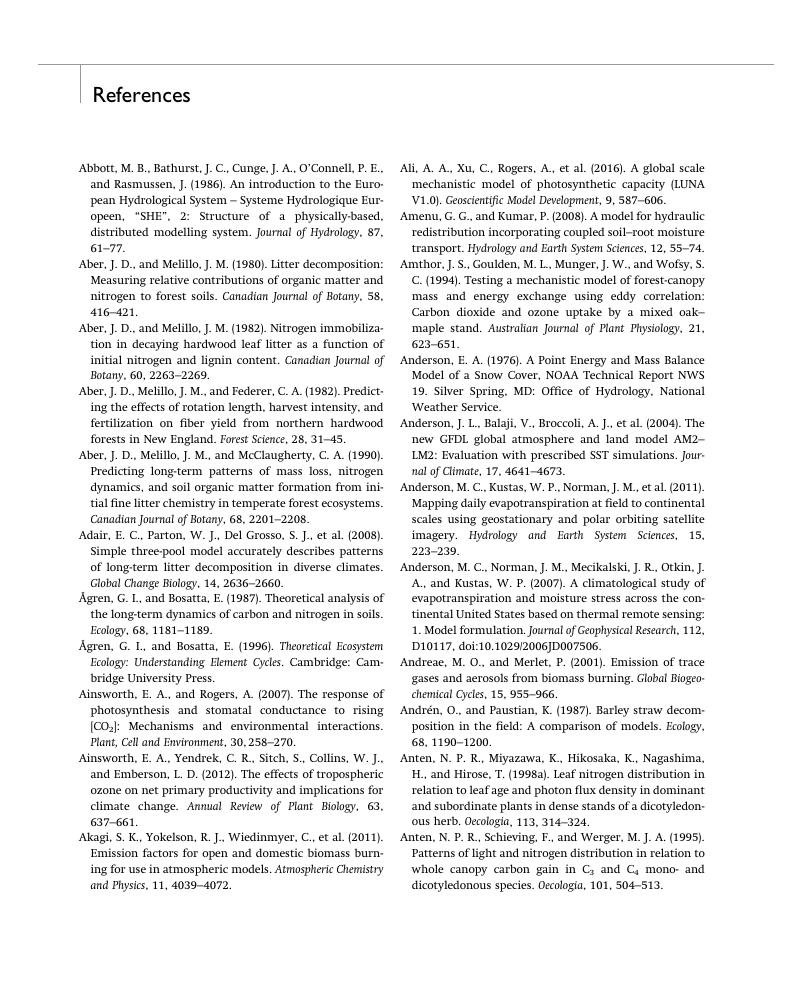Book contents
- Climate Change and Terrestrial Ecosystem Modeling
- Reviews
- Climate Change and Terrestrial Ecosystem Modeling
- Copyright page
- Dedication
- Contents
- Preface
- Mathematical Symbols
- 1 Terrestrial Biosphere Models
- 2 Quantitative Description of Ecosystems
- 3 Fundamentals of Energy and Mass Transfer
- 4 Mathematical Formulation of Biological Flux Rates
- 5 Soil Temperature
- 6 Turbulent Fluxes and Scalar Profiles in the Surface Layer
- 7 Surface Energy Fluxes
- 8 Soil Moisture
- 9 Hydrologic Scaling and Spatial Heterogeneity
- 10 Leaf Temperature and Energy Fluxes
- 11 Leaf Photosynthesis
- 12 Stomatal Conductance
- 13 Plant Hydraulics
- 14 Radiative Transfer
- 15 Plant Canopies
- 16 Scalar Canopy Profiles
- 17 Biogeochemical Models
- 18 Soil Biogeochemistry
- 19 Vegetation Demography
- 20 Canopy Chemistry
- Appendices
- References
- Index
- References
References
Published online by Cambridge University Press: 08 February 2019
- Climate Change and Terrestrial Ecosystem Modeling
- Reviews
- Climate Change and Terrestrial Ecosystem Modeling
- Copyright page
- Dedication
- Contents
- Preface
- Mathematical Symbols
- 1 Terrestrial Biosphere Models
- 2 Quantitative Description of Ecosystems
- 3 Fundamentals of Energy and Mass Transfer
- 4 Mathematical Formulation of Biological Flux Rates
- 5 Soil Temperature
- 6 Turbulent Fluxes and Scalar Profiles in the Surface Layer
- 7 Surface Energy Fluxes
- 8 Soil Moisture
- 9 Hydrologic Scaling and Spatial Heterogeneity
- 10 Leaf Temperature and Energy Fluxes
- 11 Leaf Photosynthesis
- 12 Stomatal Conductance
- 13 Plant Hydraulics
- 14 Radiative Transfer
- 15 Plant Canopies
- 16 Scalar Canopy Profiles
- 17 Biogeochemical Models
- 18 Soil Biogeochemistry
- 19 Vegetation Demography
- 20 Canopy Chemistry
- Appendices
- References
- Index
- References
Summary

Information
- Type
- Chapter
- Information
- Climate Change and Terrestrial Ecosystem Modeling , pp. 391 - 428Publisher: Cambridge University PressPrint publication year: 2019
